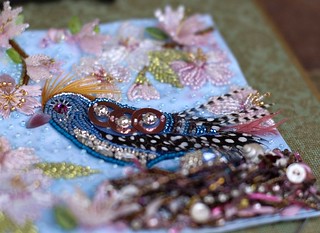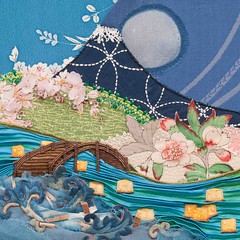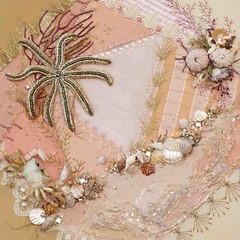After you spend many hours on something simple...like transferring embroidery patterns to a stitched foundation...three things begin to happen.

One, you get very, very good at the mechanics of transferring the pattern.
Two, the pattern becomes imprinted on your brain, kind of like a practice-run, so when it comes to stitching the goldwork...you have a good idea where you're heading because you've already been there. My teacher also has us trace the pattern before we begin...so transferring the pattern is actually the second time you've re-hearsed the pattern.
Which leads me to the third; you have plenty of time to reflect.
 Last week, a friend overheard me talking about Japanese embroidery. She had heard me mention that the actual pieces that I create in Japanese embroidery aren't necessarily what I would "choose" to stitch.
Last week, a friend overheard me talking about Japanese embroidery. She had heard me mention that the actual pieces that I create in Japanese embroidery aren't necessarily what I would "choose" to stitch.She heard me say that the only reason I was stitching them was because they are required in order to graduate from Japanese embroidery. I would really prefer to stitch designs that have more personal meaning for me. And the "graduation" part of Japanese embroidery? That has never has been a driving factor for me...as evidenced by the fact that I've been on and off Japanese embroidering for over 20 years and still haven't graduated...
"Why then," my friend asks, "do you study Japanese embroidery at all? Do you think you'll keep doing it once you graduate?"
It's a good question and so I answer it here just in case there is someone out there who may decide to study Japanese embroidery even though the projects themselves may not appeal.
So here it goes...
Why I take Japanese Embroidery
(even though many of the pieces do not speak to my soul and even though a graduation certificate isn't all that important to me either):
1. I am a much better embroiderer because of Japanese embroidery, plain and simple.
There's a method to the structure and discipline that is Japanese Embroidery. There are ten phases that a student is required to progress through sequentially. The phases are designed to introduce new techniques and new skills as the student is ready for them. Repetition, practice and time at the frame are all part of becoming a better embroiderer. This skill building approach is very different from the project-based approach that is so common in American workshops and classes.
I have a practice of Japanese embroidery just as I have a yoga practice or a swimming practice or a meditation practice. All require me to show up regularly and work. Going to Japanese embroidery class for me is like having a trainer. It pushes me to go places I wouldn't go on my own and it helps me refine my technique so that my work becomes more masterful. In Japanese embroidery it's called Nui-do...Nui meaning embroidery and do meaning way or path through skill acquisition.
A few years ago, blogging needle friend Sheila Iskin recommended I read a book called Mastery: The Keys to Success and Long-Term Fulfillment by George Leonard. Since then I have read it and re-read it and can recommend it without reservation.

When he wrote it, George Leonard had been teaching the Japanese martial art of Aikido for over 35 years. In this short but powerful book, he prescribes a guide for anyone wishing to attain mastery in any area of life.

When he wrote it, George Leonard had been teaching the Japanese martial art of Aikido for over 35 years. In this short but powerful book, he prescribes a guide for anyone wishing to attain mastery in any area of life.
His approach is brilliant and draws heavily on Japanese thinking. In his years of teaching, he has found that the most talented students are not necessarily the best students. In fact, it's often the most talented that have the greatest difficulty staying with a discipline long enough to attain mastery.
It's often those individuals who embrace hard work, who show up regularly, and who keep showing up over long stretches even when they may not be making any remarkable progress. Leonard calls these times of stagnation, plateaus...and he finds that it is on those plateaus that real masters are made.
Masters learn to love the plateaus. Find a master of any game and you'll likely find a master of practice.
It's often those individuals who embrace hard work, who show up regularly, and who keep showing up over long stretches even when they may not be making any remarkable progress. Leonard calls these times of stagnation, plateaus...and he finds that it is on those plateaus that real masters are made.
Masters learn to love the plateaus. Find a master of any game and you'll likely find a master of practice.
2. My teacher is exceptional.
When I moved back from Japan over 25 years ago, I wanted to continue my Japanese embroidery practice. Lucky for me, I live thirty minutes from Tonie Evans, a certified Japanese embroidery teacher and outstanding mentor. As I got married, had a child, and built a career...Tonie was always there for me whenever I returned to my practice. One of Leonard's keys to mastery is instruction and I hit the jackpot when it comes to that.
Not since my mother died have I found a person willing to give me honest feedback and who has my best interest at heart. My teacher wants me to succeed, she wants me to master embroidery and she is there to help guide me. Often Tonie will mention with a sense of pride, that many of her students are better stitchers than she herself. I'm not so sure if that's true but it demonstrates Tonie's unflinching belief in her students' work.
How many places can we go to get honest feedback about our embroidery today? Feedback is priceless for it helps us to refine and grow...to become our better selves.
Just this past week, Tonie was evaluating the curlicues I've been stitching in goldwork. There are many of these little guys and they require a good deal of effort to keep a nice open curve when couching the gold. Tonie praised me for the roundness of my shapes, but then told me to try to keep my couching stitches more evenly spaced.

As you round a curve, couching stitches need to be closer together...but it will look better if the spacing is consistent from shape to shape.

As you round a curve, couching stitches need to be closer together...but it will look better if the spacing is consistent from shape to shape.
There it is. The feedback I need to do better.
3. My fellow students and practitioners of Japanese embroidery are some of the most experienced, talented and wise stitchers I know.
If you adopt the practice of Japanese embroidery, you will be a better stitcher.
Many of the students that continue to come to Tonie's studio for classes are exceptional embroiderers who have adopted the lifelong learning approach to Japanese embroidery. Their wisdom and humility are constant sources of inspiration to me. Many of these women have achieved levels of mastery themselves yet they still consider themselves students. That's a lesson in and of itself.
Many of the students that continue to come to Tonie's studio for classes are exceptional embroiderers who have adopted the lifelong learning approach to Japanese embroidery. Their wisdom and humility are constant sources of inspiration to me. Many of these women have achieved levels of mastery themselves yet they still consider themselves students. That's a lesson in and of itself.
Once you complete ten phases of Japanese embroidery, you are able to take advanced classes at the Japanese Embroidery Center of Atlanta. Being able to attend the Center as an advanced student will only broaden the group of experts from whom I get to study. This is my true reason for wanting to graduate...so I can further expand and deepen my practice.
I do not study Japanese embroidery in order to finish the pieces and hang them on my wall. The Japanese embroidery projects upon which I stitch are a means to an end. They are my practice pieces; my workout spaces.
They give me greater insight into my own strengths and weaknesses and help to inform my life as an embroiderer.
I hope my honest answer to why I study might give some a few reasons to consider the study of Japanese Embroidery. All of these needlework traditions are at risk if there aren't new students to take them up.
If you'd like to give Japanese Embroidery a try, Tonie teaches here in Maryland but she has students from neighboring states , some coming from as far away as Canada. You can contact Tonie at tejapaneseembroidery (at) gmail (dot) com for more information.
The Japanese Embroidery Center in Atlanta is another place to learn and they can put you in contact with teachers from all over the world.
I hope my honest answer to why I study might give some a few reasons to consider the study of Japanese Embroidery. All of these needlework traditions are at risk if there aren't new students to take them up.
If you'd like to give Japanese Embroidery a try, Tonie teaches here in Maryland but she has students from neighboring states , some coming from as far away as Canada. You can contact Tonie at tejapaneseembroidery (at) gmail (dot) com for more information.
The Japanese Embroidery Center in Atlanta is another place to learn and they can put you in contact with teachers from all over the world.
Happy Weekend!























18 comments:
Oh my gosh, this post lets me know I'm just a 'dabbler' in the art form of embroidery.
It is good to always keep learning.
Happy Valentine's Day ~ FlowerLady
As usual I love to visit with you...you are my inspiration to try to anything I want to learn.
I have been learning Japanese Embroidery for just under 3 years and I still consider myself very much the novice. I'm drawn to JE because of the opportunity it givens me to learn the techniques. Having a teacher close by makes it so much easier to keep turning up to my frame. I also do yoga and over the past year have come to the realisation that JE is just another form of yoga for me - it brings my focus to the here and now in the midst of a busy life.
Thank you for sharing. This is a great evplainatoon if why it's okay to keep practicing. I have a similar project going in I tatted lace and I've stalled out on doing the projects. Thanks for giving me reasons why I should do them even though I don't want to do them.
I didn't proud read my comment before posting. Please forgive the spelling, autocorrect kills me!
You explain very well why you live Japanese embroidery.
It is indeed regrettable that your 'friend' does not know you.
Continue on your learning journey, although the destination and timetable change.
You seem to have a wonderful teacher. She does not pretend to be the greatest embroiderer in the world, but she has the skill to develop the expertise of her students to a very high level. a true teacher.
Thank you for sharing your beautiful embroidery. I love reading your blog!
You captured it perfectly--thank you. I work very slowly, and take long breaks some times, but I always come back to JE. It informs all of my other stitching and has since I twisted my first thread. You articulate it beautifully.
These are all the words I need to explain to friends and family why I want to take the first class of JE in 2016 when I'll finish my undergrad. I do not know a lot of people who commit to do a long lift learning like this. You are a great inspiration for me. Thank you for your words and your pictures :)
I've noticed that working the Thistle Threads pieces has had the same effect, although it isn't as structured. I think many of your readers will identify with the idea of constantly learning and improving - I know I do!
While I do love the pieces themselves and have them hanging on my walls, I agree that they are a means to an end. When I first saw JE I thought it was the most exquisite embroidery I had ever seen and I wanted to learn to stitch to that standard.
Today is the 10th anniversary of my first Japanese embroidery lesson. Although I have now learnt many of the techniques I am still working to improve my skill with a needle and always will be.
Your Sake Boxes are looking fantastic!
p.s. I love your George Leonard quote of the day, it really does sum it up very well.
Another great post, Susan. I love how you make me think! Happy Valentine's weekend!
Thank you for sharing your thoughts and inspiration for following our heart. Yes, you may be stitching for practice and the learning factor....but the love for stitching drives the desire.
xo,
Deb
Interesting post! Thank you for sharing!
http://inkandlacedesigns.blogspot.com.au/
Thanks for this essay. I have been thinking about and talking about it since you posted it.
Your desire to learn and continue to learn will keep you young and interesting forever. I like your reasoning for continuing to "practice". I don't think we can ever be finished learning and improving our skills. Thank you Susan for sharing your amazing insights.
That embroidery looks amazing. I wish I could be this good at embroidering things. Maybe I should look into Japaneses embroidery as you did. Hopefully that will help me get better. http://www.myvisualeffectsonline.com/DecorationServices1/
Post a Comment